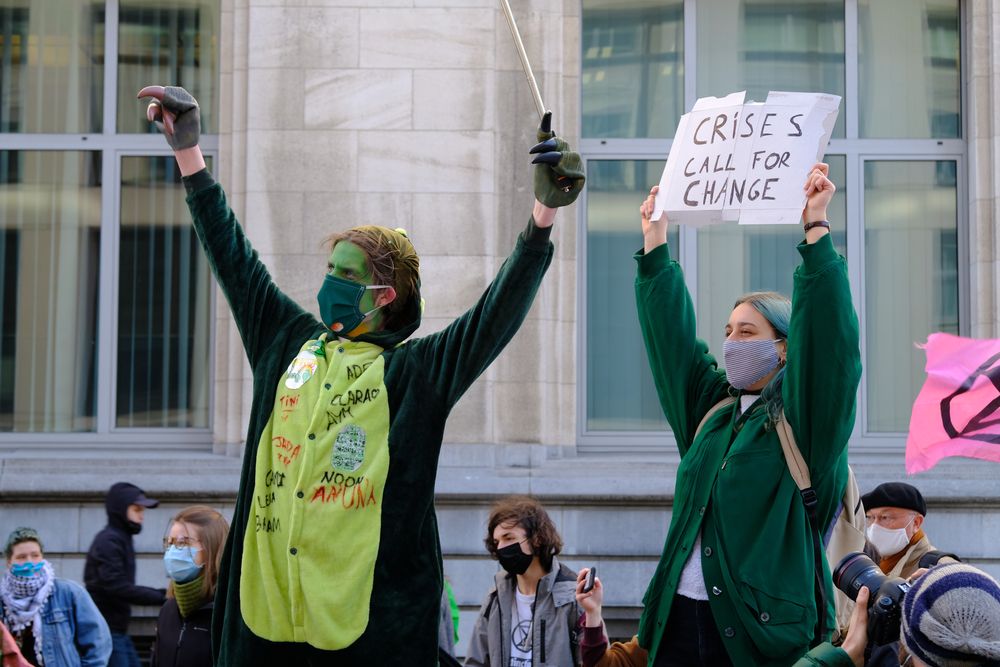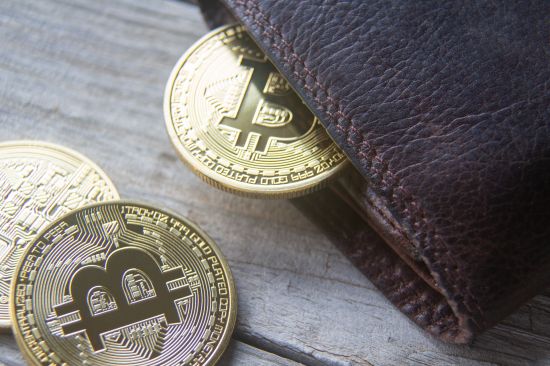Covid-19 has been a major destabilizer of national economies and the international financial system with no end in sight. Since US president Richard Nixon’s decoupling of gold from the US dollar in 1971, there has been an uncontrollable slide in the global economy with catastrophic social and political impact. Given new challenges from climate change, Christopher H Lim and Victor R Savage of the S Rajaratnam School of International Studies at Nanyang Technological University in Singapore offer a novel solution.
Youth climate strike, Brussels, March 19, 2021: Desperate measures for desperate times (Credit: PP Photos / Shutterstock.com)
The pandemic and the climate crisis have disrupted the global economy, increasing its weakness and fragility due to the asymmetry between the enormous financial economy and the real economy. The weakening US dollar and its fading dominance as a global currency are further complicating the international monetary system and increasing volatility. In this paper, we offer a novel dual-currency solution to tame the risks and set the world on a new, more stable development path.
After decades of economic turbulence and uncertainty, 44 allied nations met at Bretton Woods in the US state of New Hampshire in July 1944 to create a set of rules to govern the post-World War II international monetary system. This underscored the promotion of growth through monetary cooperation, guarantees for financial stability and international trade.
The Bretton Woods conference resulted in the formation of the International Monetary Fund (IMF) and the International Bank for Reconstruction and Development (IBRD), the flagship lending institution of the World Bank Group. The IMF was given the task of maintaining a system of fixed exchange rates centered on the US dollar and gold. With the US holding 75 percent of the world’s gold reserves and the high demand in Europe and Japan for American goods and services for rebuilding postwar economies, the Bretton Woods system took off as intended.
First, the US dollar’s underwriting of global finance has benefited the US at the expense of other economies. For the past 50 years, the US has been printing money to underwrite all its international purchases without any realistic collateral. This is likely to change with coming geopolitical shifts.
Second, with the 1973-74 oil crisis, the US established the dollar as the major trading currency for oil and gas – the petrodollar. This was a bonus for the American economy as the dollar role as an international currency for trade and finance was solidified. Given its importance, countries bought into the greenback, enhancing its value even further.
Third, the rise of China is challenging US economic hegemony and accelerating the demise of the dollar as the dominant global currency. Both China and Russia have been strong advocates of undermining the dollar’s position.
The genesis of financialization
After the termination of the Bretton Woods system, the global economy changed. Money was not only used as a tool for payment but it also became a traded commodity. Movements of money (capital movements) have overtaken trade (in both goods and services) as the driver of the global economy.
At the global level, there are two distinct economies: the Wall Street economy (capital movements, exchange rates, credit flows and derivatives) and the Main Street economy (the production and flow of goods and services). Paradoxically, they operate as if they are mutually independent of each other even though they operate within the same political boundaries and under the same jurisdictions.
The incongruity of the two economies was well documented as early as the 1980s, with Austrian-American management consultant Peter F Drucker identifying two fallouts for the financial markets. First, according to London Eurodollar market data, the yearly global amount of borrowing and lending by financial institutions was US$75 trillion, at least 25 times that of annual global trade in goods and services. Second, the yearly global amount of foreign-exchange currency transactions was US$35 trillion, about 12 times of annual global trade. Drucker observed that the transformation of the global economy had already taken place and the art of arbitrage and the science of financial engineering had taken center stage in the global economy.
In the world of financialization, no economy is spared from the attack of currency traders unless it can totally control both the inward and outward flow of funds. No country is spared from speculative options attacks by fund managers. Sterling and the Hong Kong dollar, for example, were targeted in 1992 and 1997-1998, respectively.
In the 1992 attack on the British currency, the UK suffered hefty damage of £3.3 billion. The Hong Kong dollar attack led to a drop in economic output in 1998 of more than 5 percent due to government measures to defend the currency.
The 1997-1998 Asian financial crisis revealed the lack of prudent regulatory controls. Most Asian countries faced high-risk debt in foreign currency which was exacerbated by globalist liberalization policies that allowed the free flow of international capital. Financial markets became the major levers of the global economy.
The crisis brought down stock markets, currency exchange rates and prices of other assets. The GDPs of many Asian countries fell by double digits. Due to the subsequent rise in unemployment and its socio-economic impact, there were 10,400 more suicides in 1998 than in 1997 in Japan, Hong Kong and Korea. According to Oxfam, the crisis stunted social development in many Asian countries by at least a decade, with household incomes reduced, pushing millions into poverty, and access to healthcare and schooling limited.
The advent of quantitative easing
The 2007-2008 global financial crisis (GFC) triggered huge drops in the stock market and major gyrations in national economies. Federal Reserve System Board chairman Ben Bernanke’s solution was quantitative easing (QE) with near-zero interest rates. Globally, a total of US$12 trillion in QE has been spent since the GFC. The result was the widening of wealth inequality through the boosting of prices in financial assets that were disproportionately owned by richer households. QE contributed to the decline or stagnation in developed economies of labor’s share of national incomes (wages and benefits as a percentage of GDP).
The consequences of the unprecedented QE measures by major developed countries over a decade since the GFC have been far from desirable. The vulnerabilities of emerging markets have been amplified. Aggressive inflows of capital, spurred by QE and low interest rates in developed economies have created and continue to create unsustainable debt. The stock of international bonds collected by the Bank for International Settlements (BIS) between 2009 and 2017 increased from US$297 billion to US$757 billion in the Latin America and Caribbean region and from US$253 billion to US$637 billion in the Asia Pacific.
The size and the duration of QE have further widened wealth inequality for developed countries and favored the ultra-wealthy. The wealth gap in the US has become crystal clear. As of the third quarter of 2019, the top one percent of the population holds over half of stocks and mutual funds and just 5 percent of debt, while the bottom 90 percent accounts for less than 15 percent of stocks and mutual funds and at least three quarters of debt.
The global economy under threat
The American tradition of printing money to pay debts without realistic collateral is seriously being challenged by other states, especially China, Russia and the European Union. The capital scaffolding of the international financial system is certainly on very shaky ground. If the US dollar is replaced as the world’s primary currency, the global economy would head into uncharted waters.
The two biggest challenges to the global economy today are Covid-19 and climate change. The latter is a slow but inevitable process that threatens physical infrastructure, health, biodiversity, food security and socio-economic systems. According to the recent report of the Intergovernmental Panel on Climate Change (IPCC), observable changes in climate around the globe have been detected in every region.
Efforts to mitigate climate change seem to be flagging, and there is a pessimism about the global community’s ability to arrest temperature increases as hoped. In the runup to the UN Climate Change Conference (COP26) in Glasgow in November 2021, British Prime Minister Boris Johnson has sought to lower expectations of achieving a global consensus on commitments that go beyond what was agreed in the 2015 Paris Agreement. According to the UN’s World Meteorological Organization (WMO), Asian states have the greatest stake in finding solutions to rising temperatures as they suffered the greatest infrastructure destruction, food and water insecurity, public health deterioration, environmental degradation, and human lives lost in 2020.
While the world has tried to reduce the use of fossil fuels to combat climate change, the major economic powers (Europe, China, US and Japan) have this year become mired in an energy crunch. The result: rising energy costs even as energy demand grows due to the post-Covid economic revival. Overzealous cutbacks on coal, oil and gas use and denuclearization in key economies – Germany and Japan – have led to severe energy shortages, with renewables such as solar, wind, hydroelectric and geothermal unable to meet the shortfall. This could nip the global economic recovery from the pandemic in the bud.
On top of the economic strangulation arising from climate change and the energy crunch, the Covid-19 crisis continues to wreck national economies. In two years, it has undermined global financial and trading markets. While the 2007-08 global financial crisis (GFC) was the result of economic imbalances and market manipulation and distortion, the Covid-19 crisis is a biological challenge that can only be solved by science and medicine. Yet, despite the differences in origin, the GFC and the pandemic resulted in huge drops in the stock markets of major economies similar to those of the Great Depression. As the economic damage arising from Covid-19 mounts, policymakers and monetary authorities around the world have had few viable options to arrest massive unemployment, global debt, bankruptcies and financial hemorrhaging.
The sudden financial burdens that governments have to carry to stem the economic catastrophe brought on by Covid-19 necessitated once again the adoption of quantitative easing (QE) methods – pump-priming stimulus combined with low interest rates. Four major central banks (those of the US, EU, Japan, and UK) allocated an additional US$7.8 trillion to their ongoing QE programs to cushion shocks caused by the coronavirus outbreak. Combined, the climate change emergency, the energy crunch and the Covid-19 crisis are posing unprecedented global challenges. QE is neither a sufficient nor sustainable solution.
Using existing financial market-linked prescriptions
The use of QE as a solution to the world’s economic challenges has its origins in the way the US has been printing money to underwrite its debts. QE has created a new economic catalyst in the global economy which has been possible by the digitization of financial markets. The real economy, which is based on goods and services, is space and time bound. (By contrast, financial transactions are digital and can take place in seconds.)
QE measures are short-term solutions that can lead to a recession and in the long term, widen the inequality gap between the elites and masses. Sharp disparities exist between the Wall Street and the Main Street economy. Wealth in the financial economy (Wall Street) far exceeds that in the real economy (Main Street). The middle class in developed countries have little social mobility because the real economy has been almost stagnant. At the domestic level, if QE continues unabated, inflation is a likely outcome. At the international level, so long as the financial economy is dominated by the US dollar, the global trust in the greenback is being eroded and consequently, the imbalanced top-heavy house of cards could topple over at any time.
The impact of Covid-19 is revolutionizing work, education and social activities by providing a new template for labor, services, finance, transport and trade. Just as the virus is mutating, so too is the global economy becoming more volatile and complex as a result of geopolitical changes and competition. Both the pandemic and the ailing financial system need solutions that warrant multilateral approaches but this has been hampered by intense hegemonic competition among different states, powerbrokers and economic rivals. Finance and economic competition have become the new tools of global hegemony. Consider the intense trade war between China and the US. Economic volatility and uncertainty are likely to continue until the zero-sum game possibly confirms the dominant global hegemon.
This extra tax revenue could then be channeled to fund efforts to address both climate change and the public-health crisis, as well as to bridge the income inequality gap and fund QE programs. The financial sector, after all, has had the privilege of privatizing profits and socializing losses since late 2008. This would mean that each economically sovereign state would adopt a cybercurrency for all transactions within its real economy.
If development is to take place, nationally and globally, by reducing inequality and ensuring that labor is rewarded for the production of goods and services, the world will need a new “covenant” to ensure economic sustainability and social equity. We need a comprehensive and inclusive update of the Bretton Woods agreement that would widen participation of states in the global economy and level the playing field.
To attain this, we propose taking bold steps and apply “genetic editing” to the monetary system that would create separate cybercurrencies for the real economy that will save Main Street nationally and globally. Our proposed dual currency system for every sovereign state would motivate people in Main Street to engage actively and innovate without being exploited. This would enhance the social mobility of the middle class, which has been moribund for decades.
Adopting a blockchain cybercurrency for the Main Street economy is not so unorthodox as it might sound. After all, for many years, China maintained a dual currency – one for use by locals and another, foreign exchange certificates (FECs), for use by overseas visitors who brought in hard currency. As for the audacity of this solution, it may be the time for bold action. President Nixon’s ending of the gold standard was a major unilateral currency policy action that had global ramifications. To lighten the pressure on the dollar, floating exchange rates for world currencies was initiated in 1973. With the rise of China as an economic powerhouse and the expansion of its Belt and Road Initiative (BRI) to underwrite infrastructure development in developing economies, it seems likely that China will take possibly disruptive steps to restructure the financial economy and provoke changes for greater equalization of global wealth.
An additional benefit of having two distinct currencies operating in the same jurisdiction would be the minimization of the risks from manipulative actions of the financial market and the fallout of financial crises due to financialization of the global economy. This could also assuage the undesirable monetary craving of financial elites in developing countries who behave in the same way that developed economies did when they placed “excess orders” for Covid-19 vaccines, denying poorer nations sufficient supplies. A dual currency system would create a measure of balance in the global economy between the rich and the poor, between Wall Street and Main Street.
Further reading:
Christopher H Lim
S Rajaratnam School of International Studies (RSIS), Nanyang Technological University (NTU)
Victor R Savage
S Rajaratnam School of International Studies (RSIS), Nanyang Technological University (NTU)
Check out here for more research and analysis from Asian perspectives.




